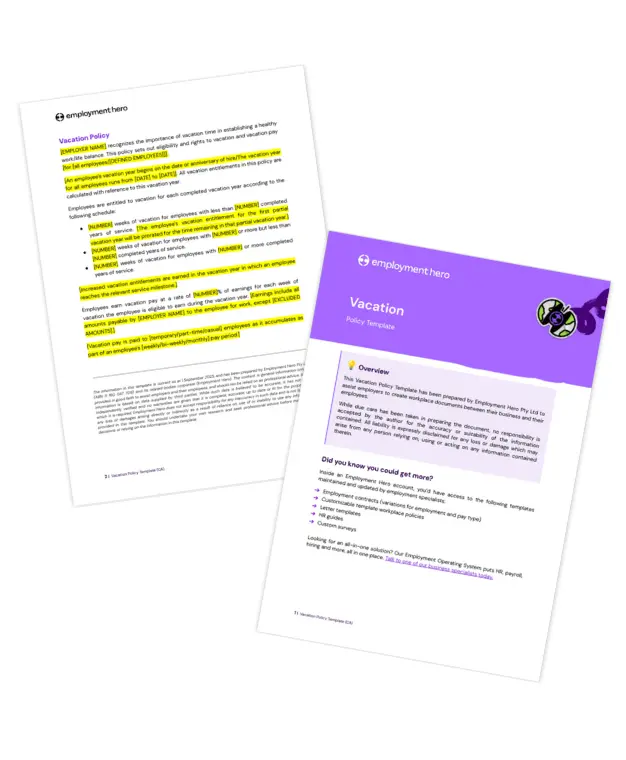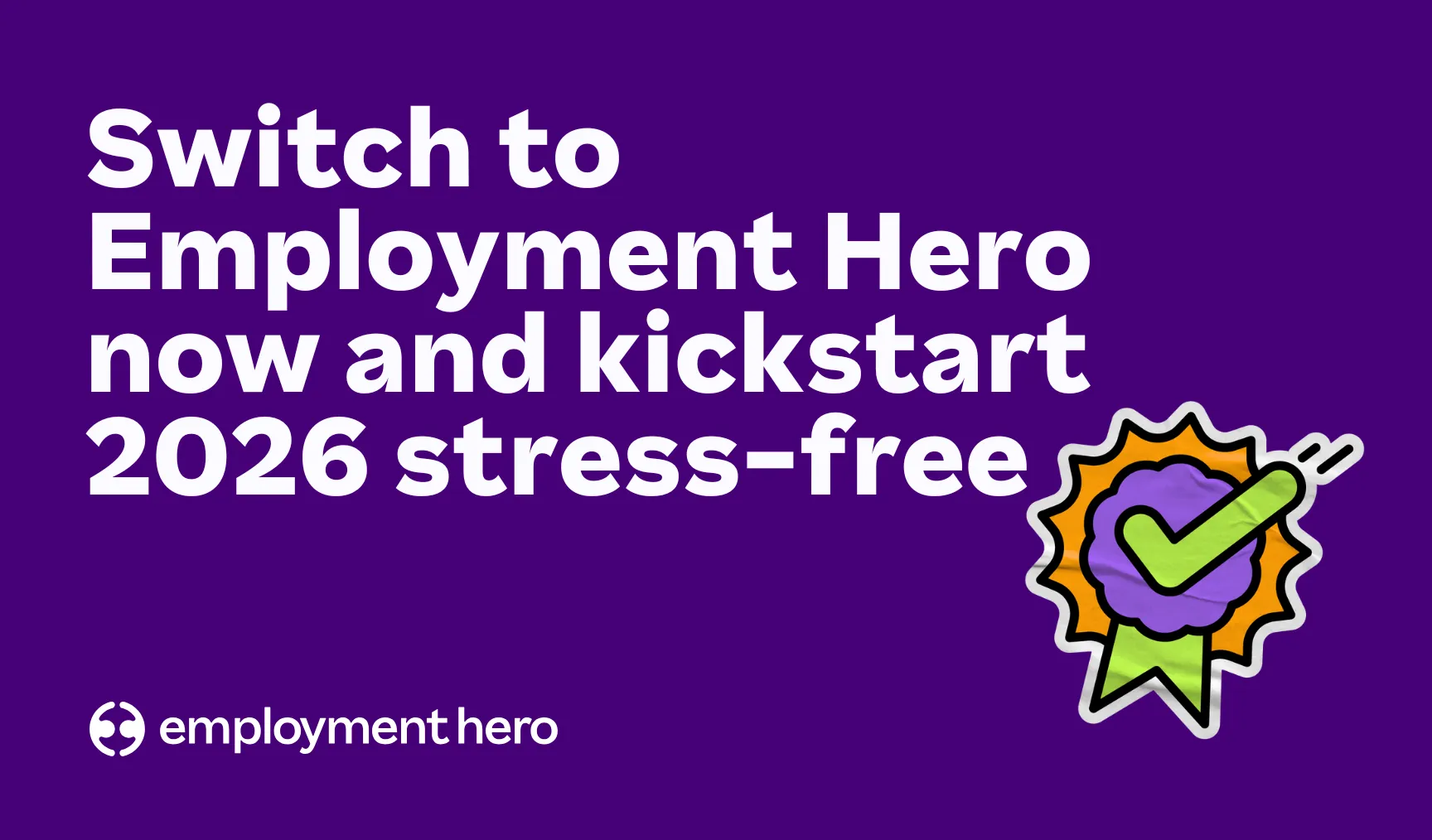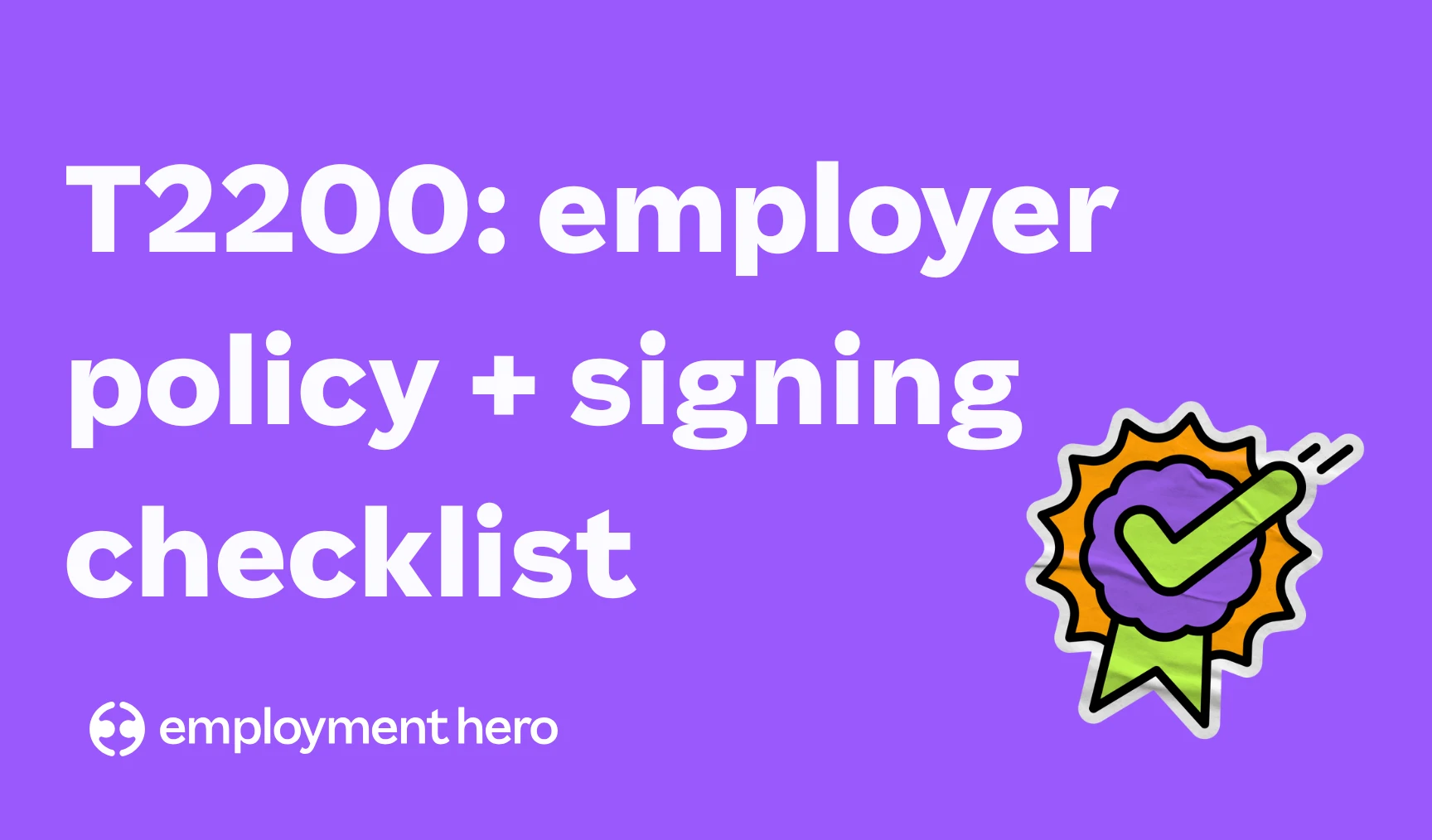Vacation Policy Template for Canadian Employers
Published
Vacation Policy Template for Canadian Employers
Published
A well-defined vacation policy is a crucial component of any successful workplace in Canada. It provides clarity for both employers and employees on vacation entitlements, ensuring fair and consistent application across the organization. By outlining expectations for vacation time and pay, a clear policy helps foster a positive work environment, promotes work-life balance and maintains compliance with Canada’s employment laws.
Our downloadable vacation policy template is designed specifically for Canadian employers. It provides a comprehensive, ready-to-use document that you can easily customize to fit your company’s unique needs. The template includes detailed sections on eligibility, accrual and vacation pay,

What is the vacation policy in Canada?
In Canada, vacation and vacation pay entitlements are governed by a combination of federal and provincial/territorial employment laws. While the specifics vary, all jurisdictions mandate a minimum amount of vacation time and pay.
Vacation days entitlements
The number of vacation days an employee is entitled to typically increases with their length of service. These are the minimum standards, and many employers choose to offer more generous vacation time as a competitive benefit.
- Federally regulated employers:
- 2 weeks of vacation annually after completing 1 year of employment.
- 3 weeks after 5 consecutive years of employment.
- 4 weeks after 10 consecutive years of employment.
Vacation Pay
Vacation pay is calculated as a percentage of an employee’s gross wages earned during the vacation entitlement year. The rate of vacation pay corresponds to the number of weeks of vacation an employee is entitled to.
- Federally regulated employers:
- 4% of gross wages for employees entitled to 2 weeks of vacation.
- 6% of gross wages for employees entitled to 3 weeks of vacation.
- 8% of gross wages for employees entitled to 4 weeks of vacation.
Please note that “gross wages” typically includes all forms of remuneration, such as salary, hourly wages, commissions and bonuses, but generally excludes tips and gratuities.
Provincial and Territorial vacation policy variations
While federal standards apply to federally regulated industries, most employers fall under provincial or territorial jurisdiction. The rules for vacation and vacation pay can differ significantly. For a quick comparison, see the table below.s. It ensures that you cover all the necessary information, protecting your business while treating your employees with respect.
| Province/territory | Minimum vacation entitlement | Minimum vacation pay |
|---|---|---|
| Federal | 2 weeks (1-4 years); 3 weeks (5-9 years); 4 weeks (10+ years) | 4% (1-4 years); 6% (5-9 years); 8% (10+ years) |
| Alberta | 2 weeks (1-4 years); 3 weeks (5+ years) | 4% (1-4 years); 6% (5+ years) |
| British Columbia | 2 weeks (1-4 years); 3 weeks (5+ years) | 4% (1-4 years); 6% (5+ years) |
| Ontario | 2 weeks (1-4 years); 3 weeks (5+ years) | 4% (1-4 years); 6% (5+ years) |
| Quebec | 2 weeks (1-2 years); 3 weeks (3+ years) | 4% (1-2 years); 6% (3+ years) |
| Saskatchewan | 3 weeks (1-9 years); 4 weeks (10+ years) | 5.77% (1-9 years); 7.69% (10+ years) |
| Nova Scotia | 2 weeks (1-7 years); 3 weeks (8+ years) | 4% (1-7 years); 6% (8+ years) |
| New Brunswick | 2 weeks (1-7 years); 3 weeks (8+ years) | 4% (1-7 years); 6% (8+ years) |
| Manitoba | 2 weeks (1-4 years); 3 weeks (5+ years) | 4% (1-4 years); 6% (5+ years) |
| Newfoundland & Labrador | 2 weeks (1-14 years); 3 weeks (15+ years) | 4% (1-14 years); 6% (15+ years) |
| Prince Edward Island | 2 weeks (1-7 years); 3 weeks (8+ years) | 4% (1-7 years); 6% (8+ years) |
| Yukon | 2 weeks (1+ years); 3 weeks (6+ years) | 4% (1-5 years); 6% (6+ years) |
| Northwest Territories | 2 weeks (1-5 years); 3 weeks (6+ years) | 4% (1-5 years); 6% (6+ years) |
| Nunavut | 2 weeks (1-5 years); 3 weeks (6+ years) | 4% (1-5 years); 6% (6+ years) |
Key aspects of a vacation policy
A well-crafted vacation policy should go beyond the legal minimums to address the practicalities of managing time off. A robust policy includes:
Vacation accrual and carry-over
This section defines how employees earn their vacation time. It can be a “use-it-or-lose-it” system (where vacation must be used within the year) or a policy that allows for a certain number of days to be carried over to the next year. It’s important to clearly state the rules to prevent disputes and liability for unused vacation time.
Request and approval process
Outline the procedure for requesting vacation, including the required notice period and the method for submission (e.g., via email, an online portal). This ensures a smooth process and helps managers plan for coverage. The policy should also specify how far in advance employees can request time off.
Vacation and statutory holidays
Clarify how statutory holidays that fall during an employee’s vacation are handled. Most jurisdictions require that the employee be given a day in lieu or an extra day of vacation.
Vacation pay administration
Detail how and when vacation pay is paid out. This can be in a lump sum before the vacation, with each regular paycheque or on the employee’s regular payday during the vacation. This section should also specify the calculation of vacation pay.
Download our free Vacation Policy for Canadian employers
Our expertly drafted template is your solution for creating a compliant and comprehensive vacation policy with ease. It covers all the essential elements required by Canadian employment standards.
What’s inside our template?
Our policy template includes:
- A clear and concise introduction that sets the tone for your company’s commitment to work-life balance.
- The exact legal language regarding vacation entitlements and vacation pay, based on employment tenure.
- A pre-written section on the vacation accrual year, which you can customize to your business.
- Placeholders for you to insert your specific policies on requesting time off, carry-over and vacation pay administration.

Tips for developing your vacation policy
When creating or updating your vacation policy, consider these best practices to ensure it is effective and fair.
Go beyond the minimums
Offering vacation entitlements that exceed the legal minimums can be a powerful tool for attracting and retaining talent. In a competitive labor market, a generous vacation policy can make you an employer of choice.
Be transparent and clear
The language in your policy should be easy for all employees to understand. Avoid jargon and ambiguity. A clear policy prevents misunderstandings and demonstrates that you value your employees’ time and well-being.
Communicate the policy effectively
Once the policy is finalized, ensure it is easily accessible to all employees. Include it in your employee handbook and review it during the onboarding process for new hires. Regular reminders can also help ensure everyone is aware of the rules.
Ready to create your vacation policy?
Developing a clear and compliant vacation policy is a critical step for any Canadian employer. It protects your business while demonstrating a commitment to your employees’ well-being. Our customizable template simplifies this process, providing you with a professional and legally sound foundation. Download our free vacation policy template today and take the first step toward a more organized and employee-friendly workplace.
Frequently asked questions
The number of vacation days varies depending on the employee’s tenure and the province or territory they work in. However, the most common minimum standard is two weeks (10 business days) of vacation after one year of employment.
Generally, once a vacation request is approved, an employer cannot unilaterally cancel it without a valid business reason. If a cancellation is necessary, the employer must provide reasonable notice and, in some cases, may be required to compensate the employee for any incurred non-refundable costs, such as flights or accommodations.
A mandatory vacation policy requires employees to take a certain amount of time off each year, often in a single block. This can be used for compliance, to reduce the risk of burnout, or for security reasons in industries where employees handle sensitive information.
Vacation leave is essential for promoting employee health, preventing burnout and improving productivity. It allows employees to rest, recharge and return to work with renewed energy and focus.
Encouraging employees to use their vacation time benefits employers in several ways. It reduces the risk of employee burnout and stress, leading to higher morale and engagement. It can also improve productivity and creativity, as well as mitigate the financial liability of unused vacation pay that accumulates over time.
The information in this template is current as at 1 September 2025, and has been prepared by Employment Hero Pty Ltd (ABN 11 160 047 709) and its related bodies corporate (Employment Hero). The content is general information only, is provided in good faith to assist employers and their employees, and should not be relied on as professional advice. Some information is based on data supplied by third parties. While such data is believed to be accurate, it has not been independently verified and no warranties are given that it is complete, accurate, up to date or fit for the purpose for which it is required. Employment Hero does not accept responsibility for any inaccuracy in such data and is not liable for any loss or damages arising directly or indirectly as a result of reliance on, use of or inability to use any information provided in this template. You should undertake your own research and seek professional advice before making any decisions or relying on the information in this template.
Register for the template
Related Resources
-
 Read more: Switch to Employment Hero now and kickstart 2026 stress-free
Read more: Switch to Employment Hero now and kickstart 2026 stress-freeSwitch to Employment Hero now and kickstart 2026 stress-free
Thinking of switching HR and payroll software? Here’s why moving to Employment Hero before 2026 sets your business up for…
-
 Read more: The career progression template that stops your best people from leaving
Read more: The career progression template that stops your best people from leavingThe career progression template that stops your best people from leaving
Download our free career progression plan template. Help employees grow, stay engaged and achieve their career goals.
-
 Read more: T2200 employer policy: The no-nonsense guide for Canadian businesses
Read more: T2200 employer policy: The no-nonsense guide for Canadian businessesT2200 employer policy: The no-nonsense guide for Canadian businesses
Learn about the T2200 tax form in Canada. Discover employer responsibilities, eligible expenses and a signing checklist to stay compliant.


















